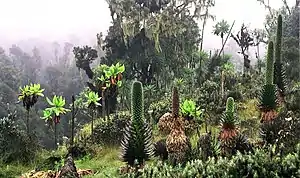Dendrosenecio adnivalis
Dendrosenecio adnivalis (synonym Senecio adnivalis) is one of the giant groundsels of the mountains of Eastern Africa. D. adnivalis grows on the Rwenzori Mountains[2] and on the Virunga Mountains[3] in Uganda and the Democratic Republic of Congo.
| Dendrosenecio adnivalis | |
|---|---|
 | |
| Giant groundsel and lobelia on Rwenzori | |
| Scientific classification | |
| Kingdom: | Plantae |
| Clade: | Tracheophytes |
| Clade: | Angiosperms |
| Clade: | Eudicots |
| Clade: | Asterids |
| Order: | Asterales |
| Family: | Asteraceae |
| Genus: | Dendrosenecio |
| Species: | D. adnivalis |
| Binomial name | |
| Dendrosenecio adnivalis | |
| Synonyms | |
|
Senecio adnivalis Stapf | |
Description
Dendrosenecio adnivalis attains heights of 6–10 m (20–33 ft) tall, trunk can be 40 centimeters diameter and the pith 3–4 cm (1.2–1.6 in) diameter.[2][4] The stems have 25 to 60 leaves densely packed in a rosette shape at the top. Old leaves are persistent,[2] withered leaf-bases covering the stalk for 1 to 3 meters below the leaf-rosettes. Leaf surfaces are elliptic to heart shaped and can be 96 cm (38 in) long and 26 cm (10 in) wide, hairy on the top and not hairy on the bottom. Branched clusters of flowers to 160 cm (63 in) tall and 60 cm (24 in) wide. The droopy flower heads have 9 to 20 ray florets, 16 millimeters long or no ray florets at all and 90 to 250 disc florets.[4]
Distribution
The Congo basin is very wet; humid air is trapped by the mountains and rain falls on most days even in the drier months. Above 2500 meters (8,200 ft) clouds can persist for several days making the Rwenzori and the Virunga a wetter environment than the other East African mountains.[5] Dendrosenecio adnivalis lives at altitudes of 3,000 to 3,800 meters (9,800 to 12,000 feet) on the Rwenzori Mountains with another giant groundsel, Dendrosenecio johnstonii. D. adnivalis more common on the wetter soils.[2]
On the Virunga Mountains groves of Senecio stanleyi (Dendrosenecio adnivalis) grow after the tree heaths (Erica sp.) in clearings along with Lobelia wollastonii until the altitude of 4,300 meters (14,000 feet) when vegetation becomes sparse.[6]
Synonyms
The herbarium has all of the Dendrosenecio adnivalis specimens filed under Senecio johnstonii[7] and indeed, one is probably a variety or subspecies of the other that adapted to live closer to water and on damper ground.[8][9]
A synonym for Senecio stanleyi is Dendrosenecio adnivalis (Stapf) E.B.Knox var. petiolatus (Hedberg) E.B.Knox; for this article, Senecio stanleyi was considered to be a synonym of Dendrosenecio adnivalis.[10]
References
- "Dendrosenecio adnivalis (Stapf) E.B.Knox record n° 183009". African Plants Database. South African National Biodiversity Institute, the Conservatoire et Jardin botaniques de la Ville de Genève and Tela Botanica. Archived from the original on 2013-01-15. Retrieved 2008-05-12.
- H. Peter Linder; Berit Gehrke (2 March 2006). "Common plants of the Rwenzori, particularly the upper zones" (PDF). Institute for Systematic Botany, University of Zurich. Archived from the original (PDF) on 2008-05-30. Retrieved 2008-05-06.
- I.Owiunji; D. Nkuutu; D. Kujirakwinja; I. Liengola; A. Plumptre; A.Nsanzurwimo; K. Fawcett; M. Gray & A. McNeilage (2005). "THE BIODIVERSITY OF THE VIRUNGA VOLCANOES" (PDF). Unpublished report. Wildlife Conservation Society. Archived from the original (PDF) on December 13, 2006. Retrieved 2008-05-12.
- Aluka. "Entry for Dendrosenecio adnivalis (Stapf) E.B.Knox [family COMPOSITAE]". African Plants. Ithaka Harbors, Inc. Retrieved 2008-05-13.
- "RWENZORI MOUNTAINS NATIONAL PARK, UGANDA". Protected Areas and World Heritage. United Nations Environment Programme and World Conservation Union. March 1994. Archived from the original on 2008-05-10. Retrieved 2008-05-06.
- "VIRUNGA NATIONAL PARK, DEMOCRATIC REPUBLIC OF THE CONGO". World Conservation Union. 1984. Archived from the original on 2008-04-30. Retrieved 2008-05-09.
- Aluka. "Results List". African Plants. Ithaka Harbors, Inc. Retrieved 2008-05-13.
- Knox, Eric B.; Jeffrey D. Palmer (October 24, 1995). "Chloroplast DNA Variation and the Recent Radiation of the Giant Senecios (Asteraceae) on the Tall Mountains of Eastern Africa". Proceedings of the National Academy of Sciences of the United States of America. National Academy of Sciences. 92 (22): 10349–10353. Bibcode:1995PNAS...9210349K. doi:10.1073/pnas.92.22.10349. JSTOR 19951024. PMC 40794. PMID 7479782.
- Knox, Eric B. (2004). "Adaptive radiation of African montane plants". In Ulf Dieckmann; Michael Doebeli; Diethard Tautz; Johan A. J. Metz (eds.). Adaptive Speciation. Cambridge University Press. ISBN 0-521-82842-2. Retrieved 2008-03-29.
- "Senecio stanleyi Hauman record n° 98843". African Plants Database. South African National Biodiversity Institute, the Conservatoire et Jardin botaniques de la Ville de Genève and Tela Botanica. Archived from the original on 2013-01-16. Retrieved 2008-05-12.
External links
- "AFPD record for Dendrosenecio adnivalis (Stapf) E.B.Knox, with infraspecific taxa and synonymy". African Plants Database. South African National Biodiversity Institute, the Conservatoire et Jardin botaniques de la Ville de Genève and Tela Botanica. Archived from the original on 2013-01-15. Retrieved 2008-05-12.
- Porter, Noah, ed. (1913). Webster's Dictionary. Springfield, Massachusetts: C. & G. Merriam Co. Missing or empty
|title=(help) - Woodward, Susan (2006-01-05). "Vegetation Zonation on East Africa's Highest Mountains". GEOG235. Radford University. Archived from the original on 2008-05-17. Retrieved 2008-05-12.